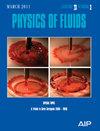结冰模型和计算方法研究
IF 4.3
2区 工程技术
Q1 MECHANICS
引用次数: 0
摘要
飞机结冰严重威胁飞行安全。本文介绍了适用于非结构网格的改进型浅水结冰热力学模型,并考虑了水物理参数变化和升华对结冰的影响。结冰计算方法可自动确定是否发生冻结以及结冰类型。开发了一种自主结冰计算程序,用于提取结冰表面的几何坐标和网格信息,并将这些信息与空气过冷水滴的多相流场相结合。戈德诺夫格式的结冰方程经过离散化处理后产生一个大规模稀疏矩阵,该矩阵使用双共轭梯度稳定法进行迭代求解。输出结果包括冰厚度、水膜厚度和平衡温度的参数分布。以国家航空咨询委员会的 0012 号机翼为研究对象,将结冰模拟结果与冰风洞的实验数据和 FENSAP-ICE 软件计算的冰形进行了比较。结果发现与实验数据非常吻合,停滞点的冰高误差小于 15%。在流冰的情况下,对常规液滴和大过冷液滴都模拟出了单角冰形。对于混合冰和釉冰,在两种液滴条件下都模拟了双角冰的形状。FENSAP-ICE 无法模拟冰角,并在冰厚度和冰范围方面产生较大误差。本文章由计算机程序翻译,如有差异,请以英文原文为准。
Research on icing model and calculation methods
Aircraft icing seriously threatens flight safety. This paper describes a modified shallow-water icing thermodynamic model that is applicable to unstructured grids and considers the effects of changes in water physical parameters and sublimation on icing. An icing calculation method enables the automatic determination of whether freezing occurs and the type of icing. An autonomous icing calculation program is developed to extract the geometric coordinates and mesh information of the icing surface and combine this information with the multiphase flow field of air-supercooled water droplets. The icing equations in the Godnov format are discretized to produce a large-scale sparse matrix that is solved iteratively using the biconjugate gradient stabilized method. The output includes parameter distributions for the ice thickness, water film thickness, and equilibrium temperature. Taking the National Advisory Committee for Aeronautic 0012 airfoil as the study object, the results of icing simulations are compared with experimental data from an ice wind tunnel and the ice shapes calculated by the FENSAP-ICE software. The results are found to be in good agreement with the experimental data, and the ice height errors at stagnation points are less than 15%. In the case of rime ice, single-horned ice shapes are simulated for both conventional and large supercooled droplets. For mixed ice and glaze ice, double-horned ice shapes are simulated for both droplet conditions. FENSAP-ICE fails to simulate the ice horns and produces large errors in ice thickness and ice range.
求助全文
通过发布文献求助,成功后即可免费获取论文全文。
去求助
来源期刊

Physics of Fluids
物理-力学
CiteScore
6.50
自引率
41.30%
发文量
2063
审稿时长
2.6 months
期刊介绍:
Physics of Fluids (PoF) is a preeminent journal devoted to publishing original theoretical, computational, and experimental contributions to the understanding of the dynamics of gases, liquids, and complex or multiphase fluids. Topics published in PoF are diverse and reflect the most important subjects in fluid dynamics, including, but not limited to:
-Acoustics
-Aerospace and aeronautical flow
-Astrophysical flow
-Biofluid mechanics
-Cavitation and cavitating flows
-Combustion flows
-Complex fluids
-Compressible flow
-Computational fluid dynamics
-Contact lines
-Continuum mechanics
-Convection
-Cryogenic flow
-Droplets
-Electrical and magnetic effects in fluid flow
-Foam, bubble, and film mechanics
-Flow control
-Flow instability and transition
-Flow orientation and anisotropy
-Flows with other transport phenomena
-Flows with complex boundary conditions
-Flow visualization
-Fluid mechanics
-Fluid physical properties
-Fluid–structure interactions
-Free surface flows
-Geophysical flow
-Interfacial flow
-Knudsen flow
-Laminar flow
-Liquid crystals
-Mathematics of fluids
-Micro- and nanofluid mechanics
-Mixing
-Molecular theory
-Nanofluidics
-Particulate, multiphase, and granular flow
-Processing flows
-Relativistic fluid mechanics
-Rotating flows
-Shock wave phenomena
-Soft matter
-Stratified flows
-Supercritical fluids
-Superfluidity
-Thermodynamics of flow systems
-Transonic flow
-Turbulent flow
-Viscous and non-Newtonian flow
-Viscoelasticity
-Vortex dynamics
-Waves
 求助内容:
求助内容: 应助结果提醒方式:
应助结果提醒方式:


